
Ants are eusocial insects of the family Formicidae and, along with the related wasps and bees, belong to the order Hymenoptera. Ants evolved from vespoid wasp ancestors in the Cretaceous period. More than 13,800 of an estimated total of 22,000 species have been classified. They are easily identified by their geniculate (elbowed) antennae and the distinctive node-like structure that forms their slender waists.
Barry Bolton is an English myrmecologist, an expert on the classification, systematics, and taxonomy of ants, who long worked at the Natural History Museum, London. He is known especially for monographs on African and Asian ants, and for encyclopaedic global works, including the Identification Guide to Ant Genera (1994), A New General Catalogue of Ants of the World, Synopsis and Classification of Formicidae (2003), and Bolton's Catalogue of Ants of the World: 1758-2005 (2007). Now retired, Bolton is a Fellow of the Royal Entomological Society and Myrmecologist, Biodiversity Division, Department of Entomology, Natural History Museum, London.

The Sri Lankan relict ant is a species of ant placed in a tribe of its own within the family Formicidae. The genus is monotypic, with the only species endemic to Sri Lanka, where it is known from just a few locations. It is one of the few ant species considered endangered.

Formica sanguinea, or blood-red ant, is a species of facultative slave-maker ant in the genus Formica characterized by the ability to secrete formic acid. It ranges from Central and Northern Europe through Russia to Japan, China, the Korean Peninsula, Africa and also the United States. This species is coloured red and black with workers up to 7 mm long.

The green-head ant, also known as the green ant or metallic pony ant, is a species of ant that is endemic to Australia. It was described by British entomologist Frederick Smith in 1858 as a member of the genus Rhytidoponera in the subfamily Ectatomminae. These ants measure between 5 and 7 mm. The queens and workers look similar, differing only in size, with the males being the smallest. They are well known for their distinctive metallic appearance, which varies from green to purple or even reddish-violet. Among the most widespread of all insects in Australia, green-head ants are found in almost every Australian state, but are absent in Tasmania. They have also been introduced in New Zealand, where several populations have been established.
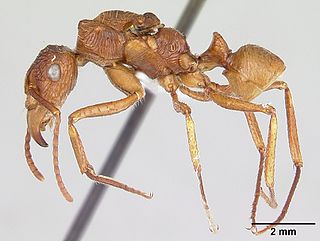
Ectatomma parasiticum is a species of ant in the subfamily Ectatomminae. Known from Mexico, the species is a social parasite of the related species Ectatomma tuberculatum. It is the only parasitic species described in the Ectatomminae subfamily, and among the rare inquilines from the tropics.
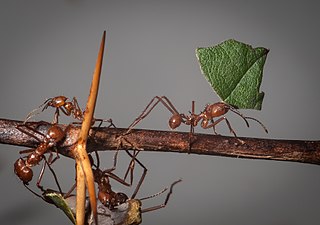
Atta cephalotes is a species of leafcutter ant in the tribe Attini. A single colony of ants can contain up to 5 million members, and each colony has one queen that can live more than 15 years. The colony comprises different castes, known as "task partitioning", and each caste has a different job to do.
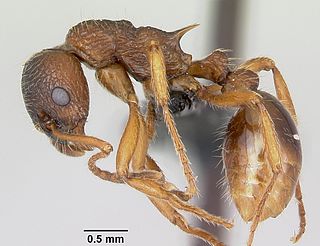
Myrmica ruginodis is a species of ant that lives in northern parts of Europe and Asia. It is very similar to M. rubra, but has a more northerly and higher-altitude distribution. Overwintering larvae may become either workers or queen ants, with up to 20 queens living in a colony of up to 2,500 individuals. Two subspecies are recognised, differing in the relative size of the queen.
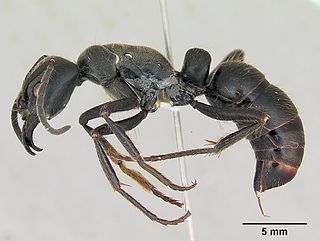
Dinoponera australis is a species of ant notable for its lack of distinct queen caste.

A gamergate is a mated worker ant that can reproduce sexually, i.e., lay fertilized eggs that will develop as females. In the vast majority of ant species, workers are sterile and gamergates are restricted to taxa where the workers have a functional sperm reservoir ('spermatheca'). In some species, gamergates reproduce in addition to winged queens, while in other species the queen caste has been completely replaced by gamergates. In gamergate species, all workers in a colony have similar reproductive potentials, but as a result of physical interactions, a dominance hierarchy is formed and only one or a few top-ranking workers can mate and produce eggs. Subsequently however, aggression is no longer needed as gamergates secrete chemical signals that inform the other workers of their reproductive status in the colony.
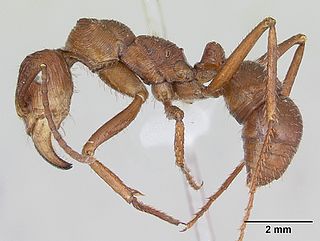
Ectatomma is a Neotropical genus of ants in the subfamily Ectatomminae. The genus contains 17 described extant species and one extinct species.

Gnamptogenys triangularis is a Neotropical species of ants in the subfamily Ectatomminae. Native to the forests of South and Central America, G. triangularis is a predatory ant that feeds on millipedes. In its native range, this species is known from Buenos Aires, Argentina in the south to Costa Rica in the north, with records from eight countries in South America, and two countries of Central America. The first records of G. triangularis outside its native range came from Florida beginning in 1985 and Alabama in 1996.

Slave-making ants or slaver ants are brood parasites that capture broods of other ant species to increase the worker force of their colony. After emerging in the slave-maker nest, slave workers work as if they were in their own colony, while parasite workers only concentrate on replenishing the labor force from neighboring host nests, a process called slave raiding.
Condylodon is a genus of ant with an uncertain placement in the family Formicidae. It contains the single species Condylodon audouini, first described from a single specimen by Lund (1831) in a paper on Brazilian ants.

Ectatomma tuberculatum is a Neotropical species of ant in the subfamily Ectatomminae. Common in the Neotropics, the species is found from Mexico to Argentina. It is a host to the related social parasite Ectatomma parasiticum, the only known parasitic species in the subfamily Ectatomminae.
This is a glossary of terms used in the descriptions of ants.

Pheidole xerophila is a species of ant and a higher myrmicine in the family Formicidae.

Ectatomma opaciventre is a South American species of ant from the subfamily Ectatomminae. In the Brazilian savannah, nests occur at low density and in specific microhabitats.














